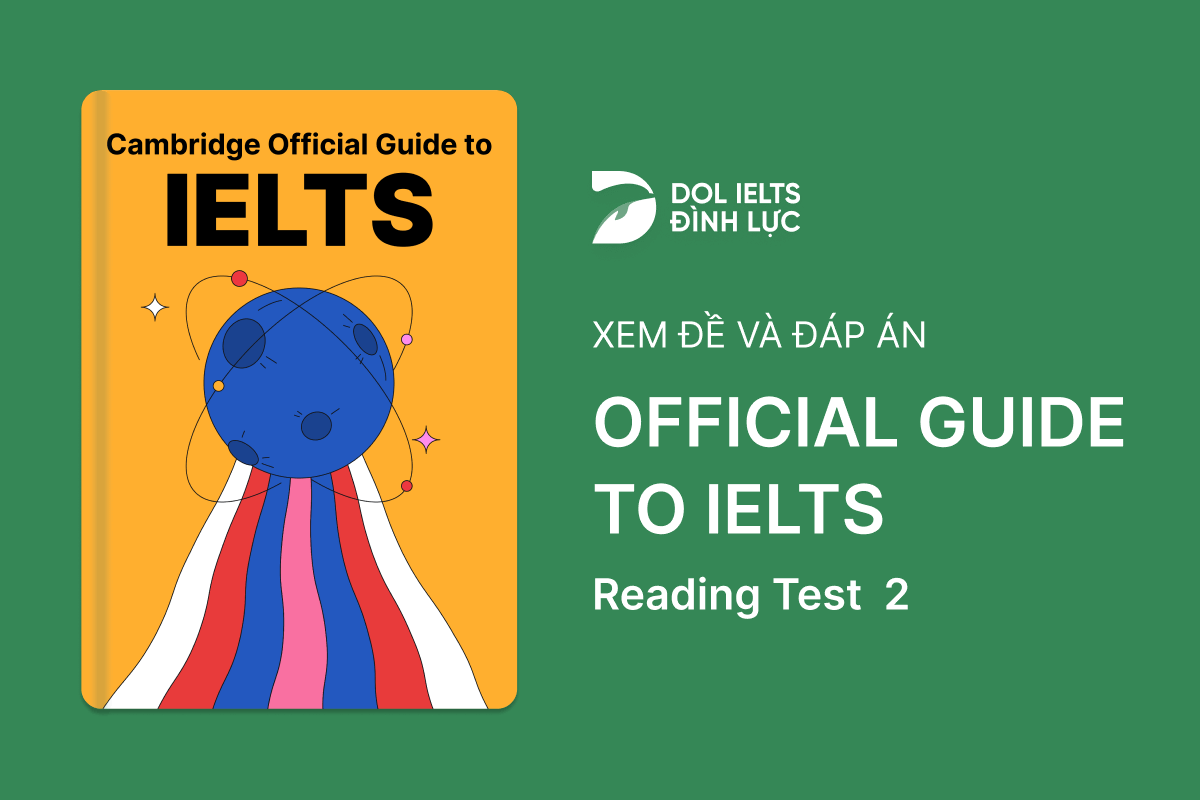Official Cambridge Guide To IELTS - Reading Test 2 With Practice Test, Answers And Explanation
Luyện tập đề IELTS Online Test Official Cambridge Guide To IELTS - Reading Test 2 được lấy từ cuốn sách Official Cambridge Guide To IELTS với trải nghiệm thi IELTS trên máy và giải thích đáp án chi tiết bằng Linearthinking, kèm answer key và list từ vựng IELTS cần học trong bài đọc.
Passage
📖 Bài đọc passage 1
❓ Câu hỏi passage 1
🔥 Đáp án & giải thích 1
Giải thích chi tiết
Linearthinking 
Khi nhìn vào câu hỏi, trước hết cần phân tích cấu trúc câu hỏi để biết cần điền loại từ nào vào chỗ trống. Vì chỗ trống đứng ngay sau chữ “term" (tên gọi) nên có thể dự đoán trong chỗ trống cần điền một Noun thể hiện tên gọi.
So sánh thông tin trong câu hỏi và bài đọc:
Khi nhìn vào câu hỏi, trước hết cần phân tích cấu trúc câu hỏi để biết cần điền loại từ nào vào chỗ trống. Vì chỗ trống đứng ngay sau chữ “term" (tên gọi) nên có thể dự đoán trong chỗ trống cần điền một Noun thể hiện tên gọi.
So sánh thông tin trong câu hỏi và bài đọc:
Bài đọc: 1 relishing them depends on a combined input from our senses
2 The taste, texture, and feel of food are what we tend to focus on , but most important are the slight puffs of air as we chew our food - what scientists call 'retronasal smell' . => We appreciate flavour because of many senses, but the most important are “retronasal smell"
=> “Retronasal smell" is the most important sense in appreciating flavour.
Câu hỏi: the term _____ characterises the most critical factor in appreciating flavour.
Passage
📖 Bài đọc passage 2
❓ Câu hỏi passage 2
🔥 Đáp án & giải thích 2
Giải thích chi tiết
Skimming/ scanning: 
Nếu chỉ skim/scan từ khoá giống nhau giữa đoạn văn và list of headings, thí sinh rất dễ chọn những heading như:
IV. Examples of robots at work
Thí sinh dễ chọn heading này khi đọc câu cuối “The Tahoe and Land Rover were being controlled by computers” => vì computers là một loại robots nên tưởng đoạn này đưa ra ví dụ robots đang làm việc. Tuy nhiên, cần chú ý rằng heading này ở số nhiều (Examples) => phải đưa ra nhiều công việc khác nhau. Trong khi đó, trong đoạn trên chỉ nói đúng một công việc của robots: lái xe.
III. How robots can save human lives
Một vài thí sinh hay chọn nhầm câu này vì “suy diễn": thấy phần trên bài đọc có đề cập tới tai nạn xe hơi, phần dưới lại nói hai chiếc xe “were controlled by computers" => suy diễn rằng computers cứu mạng con người, trong khi trong bài không hề nói tới việc này.
Linearthinking:
Nếu chỉ skim/scan từ khoá giống nhau giữa đoạn văn và list of headings, thí sinh rất dễ chọn những heading như:
IV. Examples of robots at work
Thí sinh dễ chọn heading này khi đọc câu cuối “The Tahoe and Land Rover were being controlled by computers” => vì computers là một loại robots nên tưởng đoạn này đưa ra ví dụ robots đang làm việc. Tuy nhiên, cần chú ý rằng heading này ở số nhiều (Examples) => phải đưa ra nhiều công việc khác nhau. Trong khi đó, trong đoạn trên chỉ nói đúng một công việc của robots: lái xe.
III. How robots can save human lives
Một vài thí sinh hay chọn nhầm câu này vì “suy diễn": thấy phần trên bài đọc có đề cập tới tai nạn xe hơi, phần dưới lại nói hai chiếc xe “were controlled by computers" => suy diễn rằng computers cứu mạng con người, trong khi trong bài không hề nói tới việc này.
Linearthinking: 
Để làm đúng Matching Heading, cần áp dụng Linearthinking qua hai bước Simplify + Read Connection
Simplify + Read connection
(1) - (2) Miêu tả một tai nạn xe: Câu 1 giới thiệu 2 chiếc xe, câu 2 nói về tai nạn xảy ra (there was a crack = có tiếng gãy)
(3) Việc thường xảy ra khi có tai nạn
(4) (5) Sự đặc biệt trong vụ tai nạn này: Không hề có humans mà chỉ có computers control cars.
=> Main idea: Sự khác biệt giữa vụ tai nạn này với vụ tai nạn thông thường
Để làm đúng Matching Heading, cần áp dụng Linearthinking qua hai bước Simplify + Read Connection
Simplify + Read connection
(1) - (2) Miêu tả một tai nạn xe: Câu 1 giới thiệu 2 chiếc xe, câu 2 nói về tai nạn xảy ra (there was a crack = có tiếng gãy)
(3) Việc thường xảy ra khi có tai nạn
(4) (5) Sự đặc biệt trong vụ tai nạn này: Không hề có humans mà chỉ có computers control cars.
=> Main idea: Sự khác biệt giữa vụ tai nạn này với vụ tai nạn thông thường
So với list of heading:
=> Đáp án: v. Not what it seemed to be 
Passage
📖 Bài đọc passage 3
❓ Câu hỏi passage 3
🔥 Đáp án & giải thích 3
Giải thích chi tiết
1. Skimming/scanning 
Thí sinh có thể sẽ chọn Yes vì thấy bài đọc có nhiều từ khóa trùng với câu hỏi. Tuy nhiên bài chỉ nói về việc bệnh nhân report symptoms cho doctor, không hề nói doctor sẽ làm gì.
2. Linearthinking 
Cấu trúc bài đọc:
We are required to process information to make decisions .


